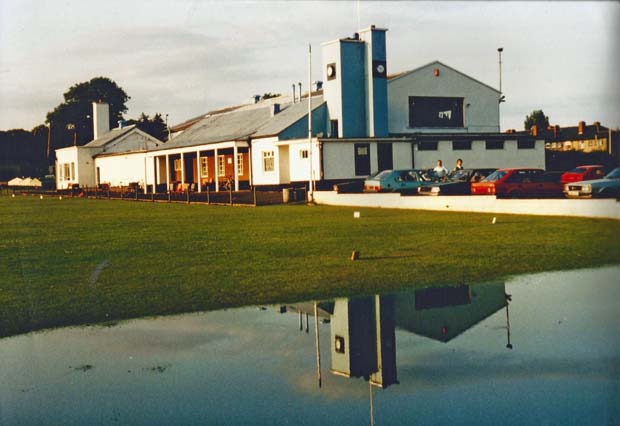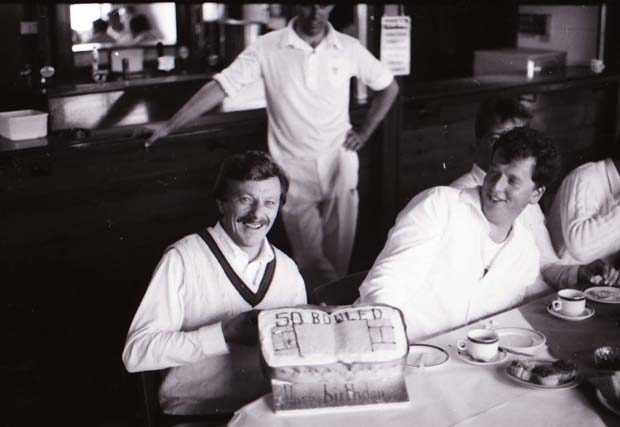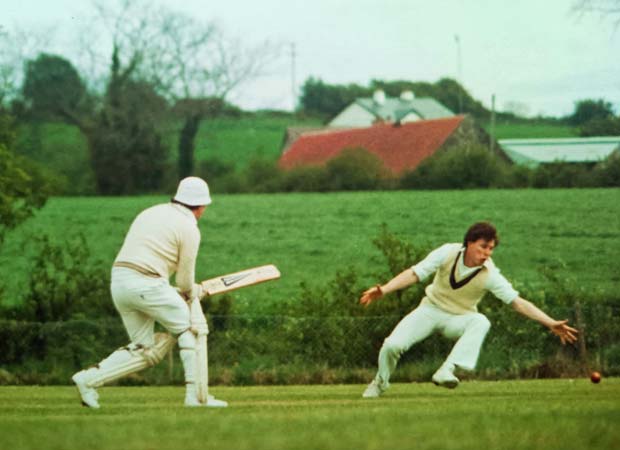All history is personal, someone may have said that before, I don't know but I'm saying it now and if it is plagiarising someone, well I apologise. RTE have a programme called Reeling in the Years which charts the happenings of a given year through news reports and TV programmes shown on the channel. It is a great series but gets worrying when items carried are topics covered in the current Leaving Cert history course. We all live through history whether we like to admit it or not, some of course through more history than others , but don't worry, young ones, your time will come.
At a Trinity game recently, I was chatting to Mikey O'Reilly and he was asking about his Dad, Peter, a fantastic and often ferocious fast bowler. I first met Mikey when he was 8 or 9 and his Dad introduced me as the batter whose teeth he had knocked out, in a game. The look of pride on the boy's face was wonderful to see even as the recipient of that O'Reilly present, but more of that later. During our chat it was clear that he knew a good bit about Peter's career but it was gratifying that a player of a current era was interested in the game played 40 odd years back.

Mikey O'Reilly
Those years now qualify as historical. While the newspapers covered the game in detail on a weekly basis, the media was a very different animal. Every Saturday evening Tom Devlin would ring around the grounds looking for scores while in Monday's paper Sean Pender reviewed the action in The Irish Times. On Saturdays Sean did his preview and often team selections were posted. In later years, Ger Siggins did similar for the Sunday Tribune, truly a labour of love.
Poor Tom would occasionally get a joker on the line and the wrong score might occasionally appear, often benefiting the person who took the call. Some clubs lost the privilege of having their scores posted after such incidents.
Nowadays games are live streamed and there is Twitter, Facebook, photographic sites, YouTube, websites such as the one where you are reading, provide instant coverage.
It was clear that Mikey accepted that his father’s cricket was not just good but very good.
Sometimes in this era of professional and semi professional cricket and cricketers, of the flood of overseas players that participate in the local game, it is forgotten that the local clubs could and still do, produce good and very good cricketers.
So this is a sort of history, but a history through the eye of a player, me, of the Senior game that I saw, of the people and places and times. A personal history.
We begin in 1981 for the purposes of this story. A mid week match against Phoenix in the Park. Clontarf often struggled with mid week games, in the midst of a recession, not everyone was in a position to take time off for a rearranged cricket fixture. So the side that the visitors put out was not the strongest version of the first eleven. A glance at the card I found in a newspaper archive suggests that 5 second team players were playing, amongst them myself and my friend Peter Prendergast. It was for both of us a first team debut. The 29th July 1981 to be precise.
On that day in London, Diana Spencer was getting married to the future King of England and I bet he didn't think that he would have to wait so long to accept that title. Phoenix were not at full strength either but there were plenty of names with which I was already familiar, names I have seen in finals and league title teams over the years.
Phoenix were one of the very best of the era. Brian Freer, Stan Mitchell, Gordon Black, David Ensor were all outstanding cricketers, Michael Halliday was their current international but he was just after playing a First Class game against Scotland, in Castle Avenue of all places, so he sat this one out and watched the wedding on TV instead, no doubt.
It wasn't much of a game to be honest, batting first, Clontarf made only 104, the debutants did ok, Peter made 17 and I made 16 and we batted together for a while which made things a bit easier for both of us. Top scorer that day was Bill Hughes, brother of Podge with a sterling 18 batting at 9. Phoenix knocked off the runs without much fuss, losing just the wicket of Neil Taylor while a relatively new face bashed the bowling about a bit in making a very stylish 62. Alf Masood found his way to the Phoenix Park the previous year and immediately set about making his mark on club, interprovincial and international cricket. As a young 16 year old it was quite something to see just how hard a cricket ball could be hit.
And so the story begins.
1982 was the year of the aforementioned Leaving Certificate so cricket took second place till that was done and dusted by the second week of July. There was drama in Castle Avenue in May, when a young girl with a fondness for setting fires decided to set one in the main bar of the Clontarf club. The nearby Oulton Tennis Club and St Annes Golf Club were her other targets that night. Mickey McTiernan spotted the flames on a late night trip to the toilet from his house on Stiles Road otherwise the damage would have been far worse than that done to the bar and ballroom. Some felt that it was a pity Mickey needed that toilet trip and the whole place could have burned. As it was the changing rooms were unaffected and the original premises consisted of three bars so two were still available for the season. Michael Delaney and Brendan Tucker became the men who drove the rebuilding of the club house into the current layout but that was in the future.
When I got married in 1995 one of the team's supporters gave me a present which was very kind. The present was a framed photograph of the burned down clubhouse and it certainly qualified as the oddest present that we received.

The 80s were a great time for the band of supporters, they followed us everywhere. Whether or not they had a background in cricket mattered not, they had an opinion and they were more than happy to let you know it. Cricket was their summer social outlet. They were semi-affectionately known as the "bar room rats" and to be honest it was not the same if the likes of Paddy Tighe, Des Byrne, Cecil Dixon, Billy Walsh or Bill O'Leary were not in their spot up beside the score box on the boundary. They gave us a hard time occasionally but they gave us great support the rest of the time.

(Cecil Dixon with John Lyon)
The supporters got the chance to travel that bit further in 1982 with the introduction of the Schweppes Irish Senior Cup. Drawn in the first round away to Bangor it was a fruitless journey as the team lost. The competition was won by NICC who beat Leinster in the inaugural final. No doubt the supporters enjoyed their jaunt up the Belfast road though.
1982 also saw CYM promoted to the Senior ranks and beat Clontarf in their first Senior game. For clarification, Senior cricket was limited to specific clubs and leagues, for example the 20 overs competition, the Alan Murray Cup was not deemed "Senior" cricket.
For years, CYM and The Hills had been knocking on the Leinster Cricket Union’s door looking for entry into the rarified ranks. Eventually CYM were allowed in for the 82 season while The Hills had to be content with Leinster Senior Cup entry this year before their debut in the Senior ranks in 1983.
CYM came with the Magic Carpet, a new thing in Leinster cricket. It had its fans but also its detractors, it has to be said. It was a topic of conversation and heated debate for many years till finally artificial wickets became commonplace. Indeed without them you would have to wonder where cricket would find itself all these years later.
I made my official first team debut later that season, by that I mean actually selected to play rather than subbed in. It was in a home game against Leinster, a powerful side they were too. but it was a day to forget as John Wills sent me packing for a big fat zero. A quick return to the 2nds was probably the result of that.
Late in August the club went on tour as they did every couple of years or so. A week in England, this occasion it was the Worcester area. The travelling squad was a mix, including first teamers such as Enda McDermott and Podge Hughes, second team captain Keith Lewis, Kieran Gleeson and some youngsters, Richie Smith, John Forrest and myself. Always a keen tourist and resident of Phoenix, Dick Forrest travelled too.
Based in Worcester town there were games against Ombersley, Hereford, Worcester City, Bewdly and Barnt Green. The Hereford ground was in the middle of the race course, while Barnt Green had a massive slope down from the pavilion to the square which was perfectly flat and then another huge drop to the far boundary. It was seemingly impossible to hit a boundary towards the pavilion, certainly on the ground, it was hard enough to stand up straight. It seems that the entire ground has now been levelled by taking soil from the upper slope and depositing on the other side, the ground is a ground for Warwickshire 2nds.
It was there that John Forrest started his commentating career. He was scoring and with a tape recorder running, he commentated on the entire game. Now you will find him on TV commentating on professional rugby. It was a good trip but tiring as being the youngster I was expected to play every game. Admittedly I was better at looking after myself than the others but it was a long ole week.
The Leaving Certificate results arrived while I was away, less said the better.
Things began to happen in 1983. Early season it was a weekly diet of Seconds but for the Irish Senior Cup I was brought along as 12th for the long trip to Donegal to play St Johnson. We travelled the night before to our Lifford hotel, we were met by one of the opposition, well known to our interpro players as a great batsman for the North West, Ian Rankin. Our lads needed little encouragement to engage in a bit of conversation over a pint, which of course became quite a few, as the night went on. There were plenty of sore heads the following morning and we were well beaten at the home team's beautiful ground. Two years in existence and still no wins in the Irish Senior Cup for Clontarf.
Against all odds I was picked as one of the two wicket keepers for the Irish under 19s for the International tournament in The Hague. Oddly both keepers were from North Leinster, Seamus O'Gorman (Old Belvedere) was the other one and we tended to share the responsibilities for NL u19s. The available best keeper in the age group was YMCA's Keith Bailey but it seems that the fact that he did not keep regularly for their first team, Frank Sowman fulfilled that role, while I kept week in week out for our seconds counted against him. Keith knows and I know that he was the best keeper but selectors, what do they know? Seamus was a very fine wicket keeper/batsman who was lost to the game when he joined the Jesuits. One of the nicest people to play cricket in Leinster.
On return from Holland I started to get my first regular run on the firsts for the Wiggins Teape League. At the time there were 2 leagues, the Senior League went by the name of Belvedere Bond League while the League cup played in the second half of the season was the Wiggins Teape League. Sometimes the format swapped with the league, it could get very confusing. I did ok, nothing special, just finding my feet.
My old pal Prendergast was in and around the team too and in July he hit his maiden senior 50 against CYM, in the process he plonked Gerry Hoey onto the Castle Avenue roof (at least the bit that hadn't been burned down) one can only imagine Gerry's reaction. In the same game Clontarf's Gerry Kirwan took 8 for 41, in the modern era an extraordinary feat but Gerry did that sort of stuff often enough for us to be a bit blase.
The phrase used around Leinster cricket was "never play back to Gerry Kirwan". It was sound advice too. Despite Sean Pender calling him a left arm spinner the truth is that Gerry very rarely tried to spin the ball. On the odd occasion that he did, it resulted in a mini fit from Enda McDermott and runs for the batter. It was the only time Gerry accepted runs hit off him, he loved to throw in a spinner, if only to wind up his good mate Enda.
Gerry was a swing bowler who just had a shortened run due to his dodgy knees. He was incredible however, metronomically accurate, he bowled to a well thought out plan. In modern parlance, his execution was exceptional. You really didn't want to be the fielder who let him down, but what a bowler, his stats, not always an accurate guide, though in this case they are, are truly remarkable, particularly as he spent a good number of years in Australia.

Gerry Kirwan
His method involved a steady line and sharp inswing. Occasionally he threw in a quicker one which was significantly quicker, harking back to his days as a tear away opening bowler but the killer ball was one thrown a little wider which gave the batter the thought of an attacking shot. However in would dart that ball and either pin the batter in front or shatter the stumps.
CYM employed a pro for their season, Roland Sampath, a policeman from Trinidad and Tobago. He was a very good player but he was far from the only pro in the league. That year Chris Kuggelijn was in Pembroke and what a player he was. He would later play for New Zealand.
Pros were not new, throughout the history of cricket in Leinster, professional cricketers have appeared but in more recent times, Robin Waters had begun his Irish career in Clontarf. In 1978 Julian Weiner came to Carlisle and pros started to become more common place. It was a constant debate regarding their place in the local game, were clubs buying success or helping to develop the home players? A debate that continues to this day.
Clontarf were stubbornly against the playing pro or hired gun as they were often referred, usually by those claiming the moral high ground. But they did have a pro, John Lyon the former Lancashire and Bangor CC wicketkeeper fulfilled the role but he had little interest in playing and only occasionally turned out, instead concentrating on his coaching brief.
A few of the younger lads were making their way onto the first team. David Fleming more commonly known as Flemo (who knows who came up with that original nickname), blazed a trail for us. Left hand bat, left arm orthodox spin and a sensational fielder he was earmarked early on.
Despite his undoubted talent it never quite happened for Flemo, certainly not to the extent that his talent suggested it might. He played in later years for Malahide as well. He was an excellent all round athlete. He played in goal in good quality football and hockey, I seem to remember he was a decent tennis or maybe squash player (knowing Flemo it was both) and when life brought him to Sligo he was a more than handy golfer. Good lad too. It helped to have some younger players around as senior cricket could be an intimidating place, certainly in Clontarf which had had a settled side for a decade or so.

David Fleming in the field at Man O' War
Next up, 1984, and a star is born.
